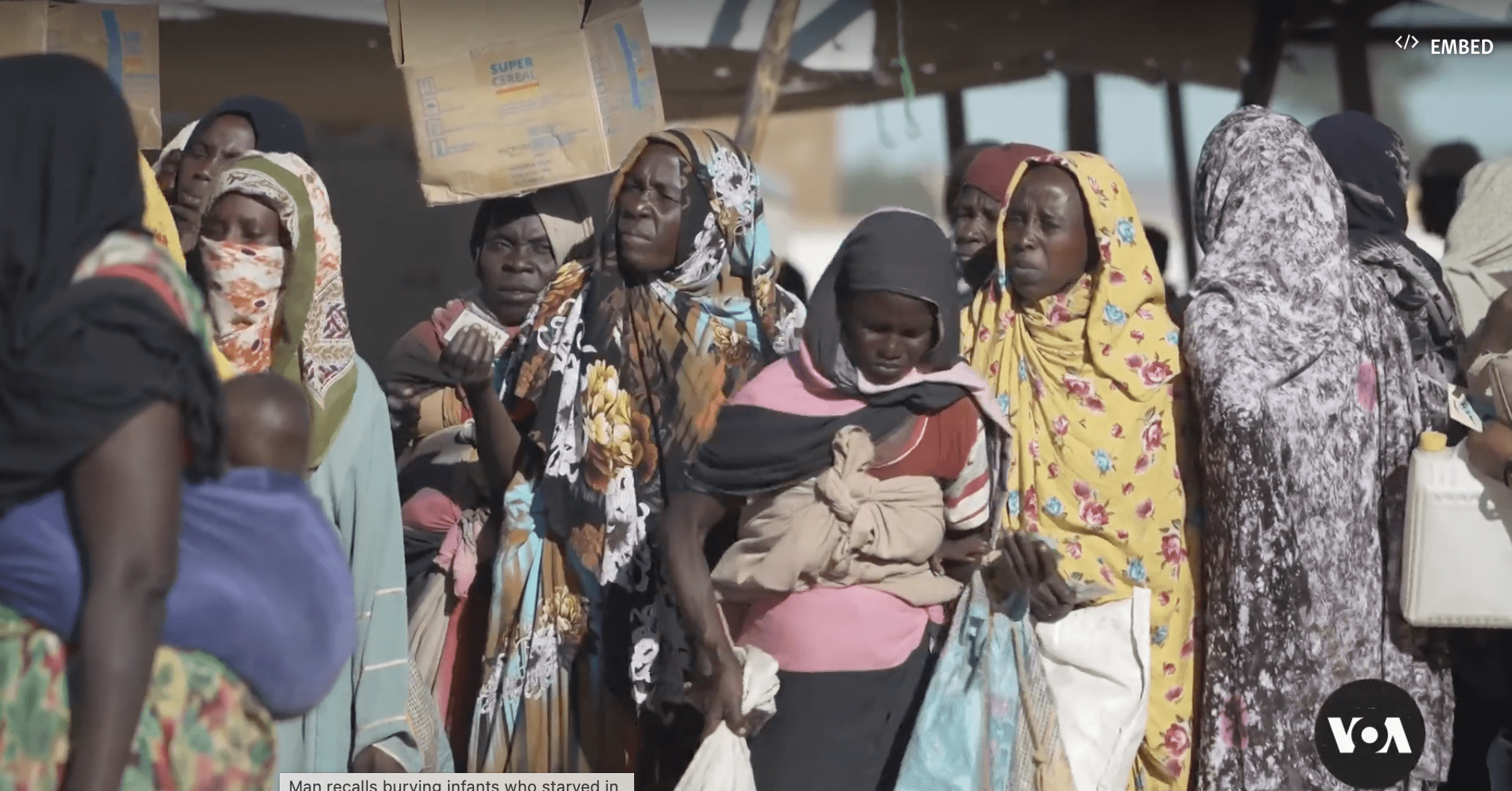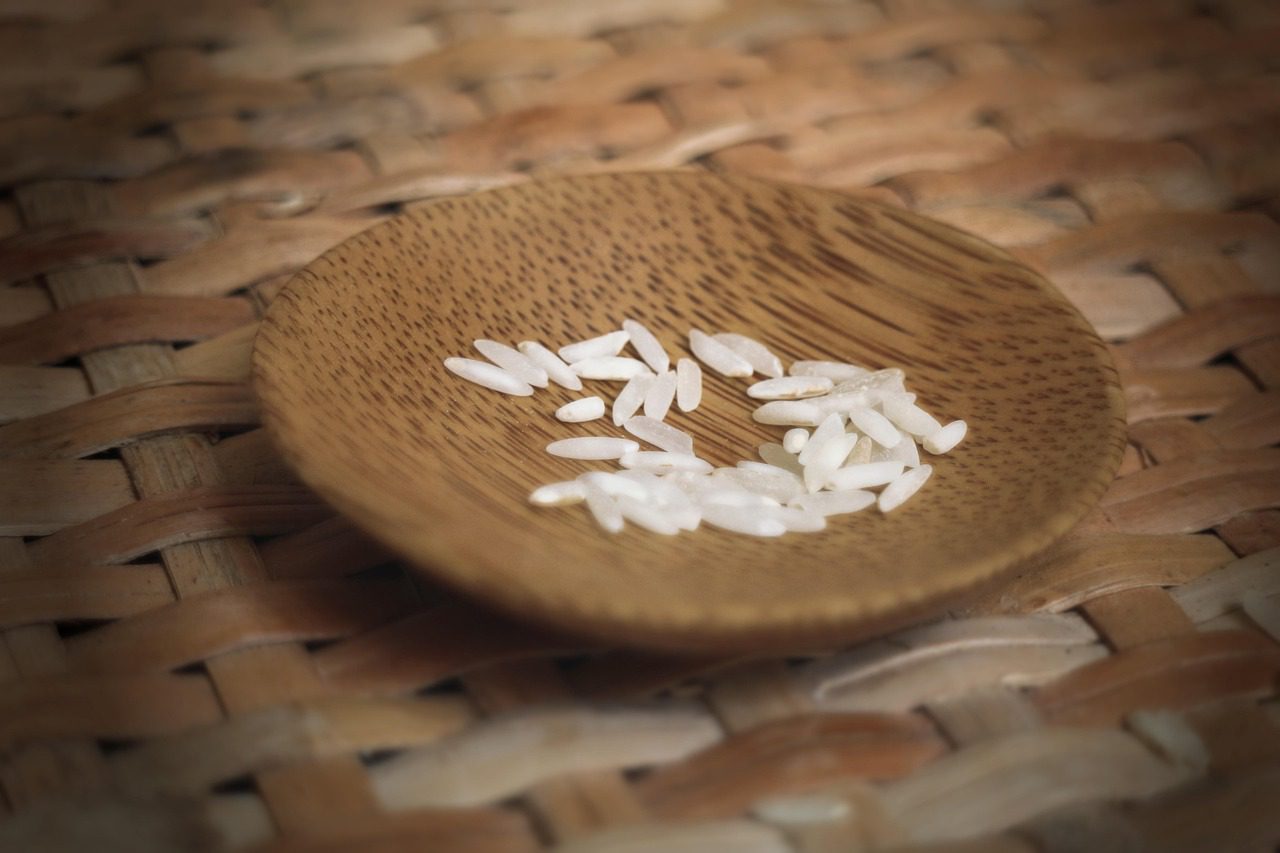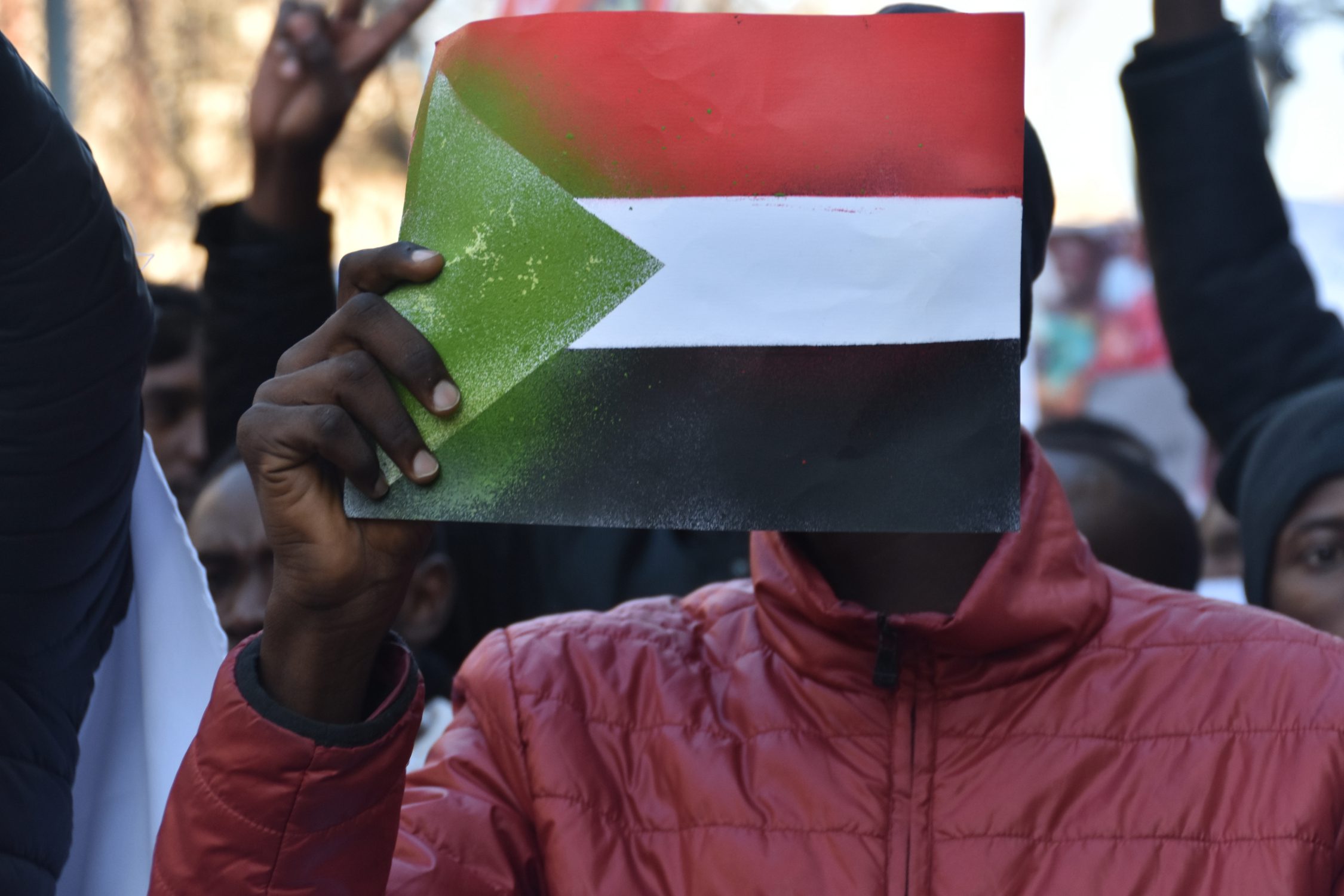This blog is part of our “Famine Voices” project, that intends to bring diverse perspectives on famine, with a particular emphasis on the voices of victims, survivors and those who are closest to them, to wider debates on the understanding of famine, including measurement, policy, theory and accountability.
This paper was written the week before the fall of al-Fashir in October 2025.
Al-Fashir under siege
A main street connecting the Daraja neighborhood and the neighbourhoods of Abu Shouk al-Hilla, on the northern side of al-Fashir. On a corner supposed to be far from the target zones stood a small mill. The mill moved there from another market, to meet the needs of people displaced to Abu Shouk.
The mill no longer ground grain: instead, it ground ‘ambaz,’ the oilseed cake residue of peanuts ground into oil. Normally, ambaz is used for animal feed. But al-Fashir’s reserves of sorghum and millet ran out during the long siege, and now it is a food for people.
The siege ended with the fall of al-Fashir in October 2025. But the starvation has not ended. During the siege, you could find citizens scrambling to grind a ball of ambaz before the drones arrived. Beggars would ask for a handful of ambaz meal, and the miller or one of his customers had to give them one.
This scene repeated daily until the Rapid Support Forces (RSF) targeted the mill with a suicide drone. Nine starving people who were queuing for ground ambaz were killed. Seven bodies were recovered. The burial party had to leave two bodies lying, because the bombing was so intense.
This is how the residents of al-Fashir, the capital of North Darfur, lived during the 500- day siege. The city was the last stronghold of the Sudanese Armed Forces (SAF), and the only Darfur frontline in its war against the RSF.
More than half a million citizens endured the severe humanitarian crisis. The health system completely collapsed. The Southern Hospital, the last hospital remaining, mainly treated infected wounds, using torn-up mosquito nets when the gauze ran out. Starving doctors buried patients themselves, and when RSF drones targeted burials, they left their patients’ bodies in graves and fled. The Southern Hospital was not even in the south: when the RSF reached the southern neighborhoods, the hospital fled to north of the city, where SAF was holding out.
The RSF severed each of al-Fashir’s supply lines. The last road to be cut linked the city with Zamzam, a displacement camp a few kilometers to the south. Zamzam housed people who fled homes in wars that began a quarter of a century before. With over 500,000 residents, it was one of the largest displacement camps in the world. It fell to RSF in April 2025. Hundreds of thousands of people were put to flight, and starvation took hold of the dining tables of each citizens.
Background to the war
Sudan’s current war began in 2023, when Sudan’s two armies turned on each other. The SAF, the successor to the colonial army, was set up in 1956. But in the 1980s and 1990s, overwhelmed by insurgencies, it outsourced most day-to-day violence to semi-privatized militias. The most successful of these militias is the RSF, which emerged over the past two decades, and was legally constituted in 2017. The two armies survived the 2019 revolution in Sudan, organized a counter-revolutionary coup in 2021, and then turned against each other.
Sudan’s war began around the capital Khartoum in April 2023. It spread quickly to Darfur, where RSF controlled the countryside, and each city had an SAF garrison. In the first months of the war, al-Fashir and other cities witnessed a series of truces. The relative calm attracted people fleeing from RSF advances across Darfur.
RSF’s siege of al-Fashir began at the end of 2023, when the RSF began severing al-Fashir’s supply lines. The first to go was the Western Salvation Road, the main road connecting the city to central Sudan and the Red Sea ports.
The war caused a crisis for former Darfurian armed opposition groups. Their insurgencies date back to the start of the twenty-first century. SAF responded to the insecurity in Darfur by setting up a series of counter-insurgency militias, of which RSF was the most successful.
The war between the insurgents and the counter insurgents ended in RSF’s favor. It all but expelled the armed opposition from Darfur. But in 2019, the Sudanese revolution forced RSF and SAF to depose their commander-in-chief, former president Omar al-Bashir. Together, RSF and SAF formed a coalition with civilians backed by the revolutionary forces. The new coalition signed a peace deal with the armed opposition movements, who joined the government. When RSF and SAF organized a counter-revolutionary coup against the civilians in 2021, several former armed opposition movements sided with the military. But When RSF and SAF began fighting each other, the former armed groups tried to reinvent themselves as neutral guards for humanitarian convoys along the Western Salvation Road.
But RSF’s capture of the Western Salvation Road forced former Darfurian opposition groups to take sides. Renaming themselves the Joint Darfur Protection Forces (Joint Forces), they joined SAF at its al-Fashir base. And when the road was captured, the battle for al-Fashir began.
At the start of the battle, traders found alternative routes to supply al-Fashir. Mellit, 90 kilometers north-east of al-Fashir, became an entrepot for goods from Libya, Chad, Egypt and Central Sudan. It lies at the intersection of the road from Chad and the Forty Days Road – a desert trade route which linked the precolonial sultanate of Darfur with Northern state (now an SAF stronghold) and Egypt, once Darfur’s main export market.
When the RSF captured Mellit in April 2024, trade was re-routed to Khazzan Jadid, about 100 kilometers south-east of al-Fashir, across the border of East Darfur state. Khazzan Jadid became the supply hub for goods going from Northern state to al-Fashir. Another trade route ran from the Chadian border through Tawila, a town in Jebel Marra, to al-Fashir. Jebel Marra is the huge massif at the center of Darfur which is held by a non-aligned armed group, the Sudan Liberation Movement of Abdulwahid Nur. Since the fall of al-Fashir, hundreds of thousands of desperate people have fled towards the relative safety of Tawila.
At first, goods moved from Khazzan Jadid and Tawila to Zamzam, a huge displacement camp on the south-eastern edge of al-Fashir. The RSF cut that route off. Trade then shifted to the Dar Sumayat area on the east of al-Fashir, and then smuggled in to Zamzam. But all that changed when Zamzam fell to the RSF in April. RSF anti-aircraft systems stopped SAF aircraft from supplying its garrison. In mid-2025, the RSF built a 31-kilometer berm, or earthen wall, to cut off passage to the north of the city. RSF checkpoints arrested people fleeing and demanded ransoms for their release. Al-Fashir became almost entirely reliant on existing stockpiles of food.
By mid-2025, al-Fashir was almost completely isolated. A few food smugglers still tried carry goods from Tawila into the city on their backs, a ten-day journey which they walked at night to hide from the RSF. During the July-September rainy season the RSF burned all the trees along the road. They captured and humiliated the young smugglers, and videoed their executions. The young food smugglers had a slogan – ‘A billion [Sudanese pounds] – or the mourning tent’ – and many fates ended in the mourning tents in the displacement centres of the famished city. For ten days, no food or medicine entered the city, and it fell to the RSF on 26 October.
Famine voices
The famine in al-Fashir is man-made. The captured supply lines, the daily shelling of markets, hospitals and public infrastructures, the drone strikes on bomb shelters, and on mosques, the infected wounds and the collapse of food and medical supplies were all the result of human decisions. More than 13,000 people have been killed. Many died in massacres: the September attack on the mosque in Abu Shouk al-Hillah killed 70 people. These numbers are not even accurate. They only represent the numbers of people whose remains were recovered, when many bodies lay in inaccessible streets.
The people trapped inside the city faced a stark choice: remain under bombardment and starvation, or flee to the unknown, along the Tawila road, where hundreds of thousands fled since Zamzam fell and 1,500 of its people were massacred. Many still lay as unburied corpses along the road.
Nonetheless, in the days before the fall of al-Fashir, hundreds of families reached Tawila each day. Half a million people remained trapped in the starving city. When the ambaz ran out, they began boiling cowhides. The al-Fashir Resistance Committees Coordination reported that 239 children have died of starvation within the city, and water has become so scarce that a gallon costs 1,500 Sudanese pounds (about US $0.40).
Fatima Hamed Muhammad is a 65-year old women who was feeding her ten children after their father died. She told her stories of the hunger. It was like hell. They had not eaten for three days in a row. They lost their home when RSF stormed their neighborhood, and they slept on the ground. Her older sons had fled and her younger ones are trapped between the jaws of starvation and shelling in the bomb shelters. Two sisters and a son died in the shelling, but her only concern was to feed herself and her children, after the ambaz ran out. The communal kitchens which once resisted hunger have stopped. Nobody was giving out aid. She ate scraps if she could find them, tightened her belt, and waited for a communal kitchen to provide.
Many communal kitchens were run by the al-Fashir Resistance Committees Coordination, which issued appeals for safe corridors for food and escape, explaining that some people, overcome by hunger, were brought to the communal kitchens on handcarts because they could no longer walk.
Dr. Arafa, who works at a health center for pregnant and breastfeeding women, tells the story of a woman stranded in El Fasher, seven months pregnant. She ate a single meal of ambaz a day. She sweetened it with a yucky junkfood juice known as Kill Me Softly. The woman lived off this diet for seven months. She stayed in al-Fashir because she had five miscarriages before her current pregnancy, and she dared not walk to Tawila: her husband was a disabled soldier. The last time Dr Arafa saw her patient, she gave the expectant mother some vitamins. She woman promised Dr Arafa that she would leave al-Fashir as soon as she gave birth. But she and her unborn child died in another attack on Abu Shouk al-Hilla.
Yasser Ibrahim, one of the volunteers trying to keep society going, said the situation in El Fasher was unbearable, especially for children. They were starving in the shelters, and their mothers could only give them hot water. The price of a two-kilo measure of ambaz reached 50,000 Sudanese pounds (about US $12.50) in cash, and double that for people using bank apps. Children lived off hot water for days. Families begged for ambaz, or a piece of meat from the communal kitchens. Everyone was begging, and even if beggars got money, there was nothing to spend it on, in a city with no markets, no food, and no medicine. Nobody talked about the people who died of hunger.



